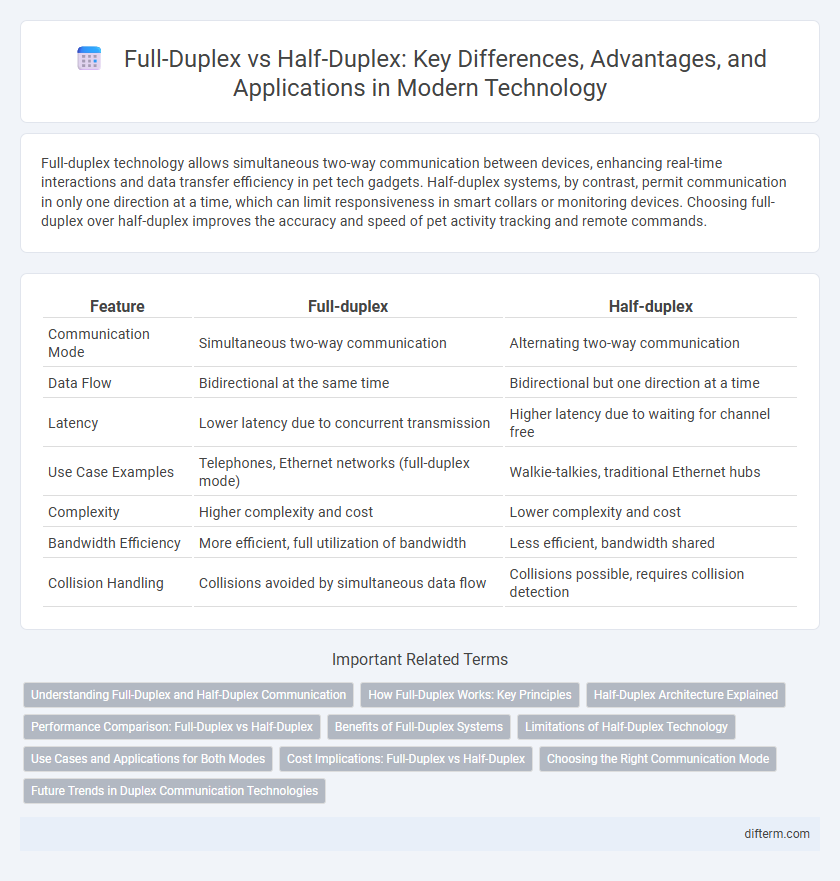Full-duplex technology allows simultaneous two-way communication between devices, enhancing real-time interactions and data transfer efficiency in pet tech gadgets. Half-duplex systems, by contrast, permit communication in only one direction at a time, which can limit responsiveness in smart collars or monitoring devices. Choosing full-duplex over half-duplex improves the accuracy and speed of pet activity tracking and remote commands.
Table of Comparison
| Feature | Full-duplex | Half-duplex |
|---|---|---|
| Communication Mode | Simultaneous two-way communication | Alternating two-way communication |
| Data Flow | Bidirectional at the same time | Bidirectional but one direction at a time |
| Latency | Lower latency due to concurrent transmission | Higher latency due to waiting for channel free |
| Use Case Examples | Telephones, Ethernet networks (full-duplex mode) | Walkie-talkies, traditional Ethernet hubs |
| Complexity | Higher complexity and cost | Lower complexity and cost |
| Bandwidth Efficiency | More efficient, full utilization of bandwidth | Less efficient, bandwidth shared |
| Collision Handling | Collisions avoided by simultaneous data flow | Collisions possible, requires collision detection |
Understanding Full-Duplex and Half-Duplex Communication
Full-duplex communication enables simultaneous two-way data transmission, allowing devices to send and receive information concurrently, which significantly enhances network efficiency and reduces latency. Half-duplex communication permits data transmission in both directions but only one direction at a time, requiring devices to alternate sending and receiving, resulting in potential delays and lower throughput. Understanding these modes is crucial for designing communication systems, with full-duplex favored in high-speed networks like Ethernet and half-duplex still common in walkie-talkies and older radio systems.
How Full-Duplex Works: Key Principles
Full-duplex communication allows simultaneous two-way data transmission by using separate channels or advanced signal processing techniques to avoid collision, doubling the data flow efficiency compared to half-duplex systems. It relies on key principles such as frequency division duplexing (FDD), time division duplexing (TDD), or echo cancellation to enable concurrent sending and receiving of signals. This technology is essential in modern networking devices like Ethernet switches and cellular systems, significantly improving throughput and reducing latency.
Half-Duplex Architecture Explained
Half-duplex architecture allows data transmission in both directions but not simultaneously, enabling devices to send and receive signals alternately over the same channel. This communication method reduces hardware complexity and bandwidth requirements compared to full-duplex systems, making it ideal for walkie-talkies and traditional Ethernet hubs. Half-duplex relies on collision detection and control protocols to manage transmission timing and prevent data overlap.
Performance Comparison: Full-Duplex vs Half-Duplex
Full-duplex communication transmits and receives data simultaneously, effectively doubling channel capacity compared to half-duplex systems that alternate between sending and receiving. Full-duplex reduces latency and increases throughput, making it ideal for real-time applications such as video conferencing and online gaming. Half-duplex, while simpler and cost-effective, suffers from bottlenecks due to collision avoidance and limited bandwidth efficiency in high-traffic environments.
Benefits of Full-Duplex Systems
Full-duplex systems enable simultaneous two-way communication, significantly increasing data transmission efficiency compared to half-duplex systems. This capability reduces latency and enhances network performance, making full-duplex ideal for high-demand applications such as video conferencing and real-time gaming. Improved bandwidth utilization and minimized transmission delays contribute to its superior effectiveness in modern communication infrastructures.
Limitations of Half-Duplex Technology
Half-duplex technology limits communication by allowing data transmission in only one direction at a time, leading to potential delays and reduced efficiency in real-time applications. This constraint causes increased latency and collision risk in networks like walkie-talkies and legacy Ethernet systems. In contrast, full-duplex systems enable simultaneous two-way communication, enhancing throughput and performance in modern networking environments.
Use Cases and Applications for Both Modes
Full-duplex communication is essential in video conferencing and online gaming, where simultaneous two-way data transmission enhances real-time interaction and reduces latency. Half-duplex systems, commonly used in walkie-talkies and traditional radio communication, prioritize simplicity and cost-effectiveness by allowing one-way data transmission at a time. Industrial automation and vehicular networks often employ half-duplex modes for efficient and reliable control signaling without the complexity of simultaneous data exchange.
Cost Implications: Full-Duplex vs Half-Duplex
Full-duplex communication systems require more complex hardware such as separate transmit and receive channels, increasing initial investment and maintenance costs compared to half-duplex systems. Half-duplex technology leverages simpler, cost-effective designs by allowing bidirectional communication on a single channel but at the expense of reduced data throughput and potential delays. Organizations must weigh the higher upfront costs of full-duplex against the operational efficiency benefits for applications demanding simultaneous two-way communication.
Choosing the Right Communication Mode
Selecting the appropriate communication mode between full-duplex and half-duplex depends on specific network requirements such as data transfer speed and channel efficiency. Full-duplex enables simultaneous two-way communication, ideal for high-bandwidth applications like video conferencing and real-time gaming, while half-duplex supports bidirectional communication but only one direction at a time, suitable for walkie-talkies and legacy network systems. Evaluating factors like latency sensitivity, hardware capability, and interference levels ensures optimal performance and resource utilization in communication networks.
Future Trends in Duplex Communication Technologies
Future trends in duplex communication technologies emphasize the expansion of full-duplex systems to enhance data throughput and reduce latency in 5G and beyond networks. Advances in self-interference cancellation techniques enable simultaneous transmission and reception on a single frequency channel, boosting spectral efficiency significantly. Integration of AI-driven adaptive algorithms further optimizes duplex modes dynamically, improving network performance in real-time applications such as IoT and autonomous systems.
Full-duplex vs Half-duplex Infographic

 difterm.com
difterm.com